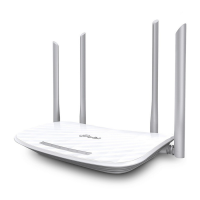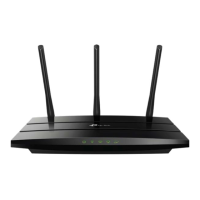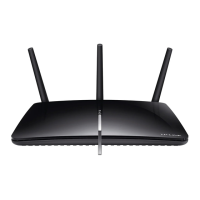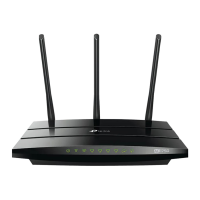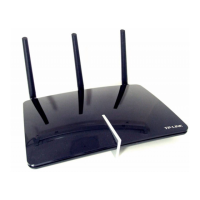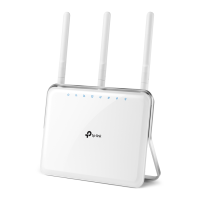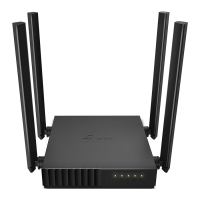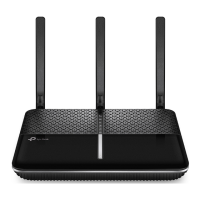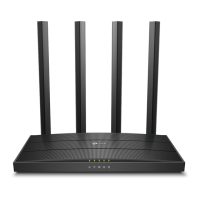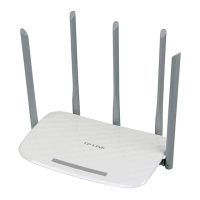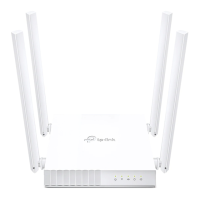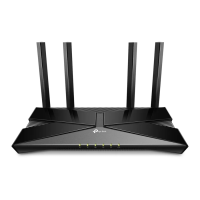Do you have a question about the TP-Link Archer A6 and is the answer not in the manual?
Explains symbols, formatting, and notes used throughout the user guide for clarity.
Provides links to TP-Link's download center, support, and community forums for additional help.
Introduces the TP-Link router's design for SOHO networks, highlighting powerful antennas and Ethernet ports.
Details the front and back panels of the router, including LED indicators and physical ports.
Provides recommendations for optimal router placement to avoid moisture, heat, and electromagnetic interference.
Step-by-step instructions on connecting the modem, router, and power adapter for initial setup.
Guides users on how to access the router's web interface via a browser and set up an administrator password.
Outlines the use of the Quick Setup Wizard for an automated and guided internet connection configuration process.
Details manual configuration options for various internet connection types like Dynamic IP, PPPoE, and Static IP.
Explains how to configure IPv6 internet connections, supporting types like PPPoE, Dynamic IP, and 6to4 tunnels.
Describes how to configure the router to operate in Access Point mode to extend an existing wired network wirelessly.
Guides on registering a TP-Link ID, changing account information, and managing user accounts for router access.
Explains how to download and use the TP-Link Tether app for managing the router from a smartphone or tablet.
Provides instructions on how to set up a unified Wi-Fi network using TP-Link OneMeshTM routers and extenders for seamless roaming.
Details how to view and manage devices connected to the OneMeshTM network through the router's web interface.
Guides on creating a separate Wi-Fi network for guests, including setting SSID, security, and password.
Explains how to customize guest network settings, such as allowing guests to see each other or access the local network.
Covers setting up access restrictions, blocking content, and defining time limits for family members' devices.
Explains how to monitor internet usage, view visited websites, and track time spent online by specific users.
Details how to configure QoS to prioritize internet traffic for specific devices, ensuring faster connections for critical applications.
Explains how to use SPI Firewall and DoS Protection to safeguard the network against cyber threats and unauthorized access.
Guides on implementing Access Control to block or allow specific devices based on MAC or IP addresses using Blacklist/Whitelist.
Describes how to use IP & MAC Binding to prevent ARP spoofing and secure the network by binding IP addresses to MAC addresses.
Explains how to enable ALG features to support specific application protocols like FTP, RTSP, and SIP for NAT traversal.
Details setting up Virtual Servers to share local network resources like websites or FTP servers with the internet.
Covers configuring Port Triggering to dynamically open external ports for applications like online games and VoIP.
Explains how to configure a DMZ host to expose a PC to the internet for unlimited bidirectional communication, useful for online gaming.
Describes how UPnP facilitates automatic port opening for applications like online games and VoIP, ensuring seamless connections.
Provides detailed steps for setting up an OpenVPN server on the router for secure remote access to the home network.
Guides on setting up a PPTP VPN server, offering an easier alternative for remote access with faster speeds.
Explains how to change the router's LAN IP address and subnet mask to avoid conflicts or customize the local network.
Details how to configure the router to support IPTV services, including IGMP proxy and various modes like Bridge or Custom.
Covers configuring the DHCP server, setting the IP address pool, and reserving IP addresses for specific client devices.
Guides on setting up Dynamic DNS to access the router remotely using a domain name instead of a changing IP address.
Explains how to manually configure static routes for directing network traffic to specific destinations.
Details how to customize wireless network settings, including SSID, password, security options, and smart connect features.
Explains how to use Wi-Fi Protected Setup (WPS) for an easier and secure wireless connection setup.
Covers setting the router's system time for accurate logging and scheduling, and controlling LED indicators.
Details how to use diagnostic tools like Ping and Traceroute to test network connectivity and troubleshoot issues.
Guides on upgrading router firmware for new features and backing up/restoring configuration settings for safety.
Explains how to schedule router reboots for performance and manage login passwords, including recovery options.
Details configuring local and remote management access, including MAC address authentication and specifying allowed devices.
Covers saving system logs for troubleshooting and monitoring internet traffic statistics for network performance analysis.
Explains advanced wireless parameters and setting up WDS bridging to extend wireless network coverage.
Guides on integrating the TP-Link router with Amazon Alexa for voice control of network devices and functions.
Addresses common issues like forgetting wireless passwords, web management login problems, and inability to connect to the internet.
Explains symbols, formatting, and notes used throughout the user guide for clarity.
Provides links to TP-Link's download center, support, and community forums for additional help.
Introduces the TP-Link router's design for SOHO networks, highlighting powerful antennas and Ethernet ports.
Details the front and back panels of the router, including LED indicators and physical ports.
Provides recommendations for optimal router placement to avoid moisture, heat, and electromagnetic interference.
Step-by-step instructions on connecting the modem, router, and power adapter for initial setup.
Guides users on how to access the router's web interface via a browser and set up an administrator password.
Outlines the use of the Quick Setup Wizard for an automated and guided internet connection configuration process.
Details manual configuration options for various internet connection types like Dynamic IP, PPPoE, and Static IP.
Explains how to configure IPv6 internet connections, supporting types like PPPoE, Dynamic IP, and 6to4 tunnels.
Describes how to configure the router to operate in Access Point mode to extend an existing wired network wirelessly.
Guides on registering a TP-Link ID, changing account information, and managing user accounts for router access.
Explains how to download and use the TP-Link Tether app for managing the router from a smartphone or tablet.
Provides instructions on how to set up a unified Wi-Fi network using TP-Link OneMeshTM routers and extenders for seamless roaming.
Details how to view and manage devices connected to the OneMeshTM network through the router's web interface.
Guides on creating a separate Wi-Fi network for guests, including setting SSID, security, and password.
Explains how to customize guest network settings, such as allowing guests to see each other or access the local network.
Covers setting up access restrictions, blocking content, and defining time limits for family members' devices.
Explains how to monitor internet usage, view visited websites, and track time spent online by specific users.
Details how to configure QoS to prioritize internet traffic for specific devices, ensuring faster connections for critical applications.
Explains how to use SPI Firewall and DoS Protection to safeguard the network against cyber threats and unauthorized access.
Guides on implementing Access Control to block or allow specific devices based on MAC or IP addresses using Blacklist/Whitelist.
Describes how to use IP & MAC Binding to prevent ARP spoofing and secure the network by binding IP addresses to MAC addresses.
Explains how to enable ALG features to support specific application protocols like FTP, RTSP, and SIP for NAT traversal.
Details setting up Virtual Servers to share local network resources like websites or FTP servers with the internet.
Covers configuring Port Triggering to dynamically open external ports for applications like online games and VoIP.
Explains how to configure a DMZ host to expose a PC to the internet for unlimited bidirectional communication, useful for online gaming.
Describes how UPnP facilitates automatic port opening for applications like online games and VoIP, ensuring seamless connections.
Provides detailed steps for setting up an OpenVPN server on the router for secure remote access to the home network.
Guides on setting up a PPTP VPN server, offering an easier alternative for remote access with faster speeds.
Explains how to change the router's LAN IP address and subnet mask to avoid conflicts or customize the local network.
Details how to configure the router to support IPTV services, including IGMP proxy and various modes like Bridge or Custom.
Covers configuring the DHCP server, setting the IP address pool, and reserving IP addresses for specific client devices.
Guides on setting up Dynamic DNS to access the router remotely using a domain name instead of a changing IP address.
Explains how to manually configure static routes for directing network traffic to specific destinations.
Details how to customize wireless network settings, including SSID, password, security options, and smart connect features.
Explains how to use Wi-Fi Protected Setup (WPS) for an easier and secure wireless connection setup.
Covers setting the router's system time for accurate logging and scheduling, and controlling LED indicators.
Details how to use diagnostic tools like Ping and Traceroute to test network connectivity and troubleshoot issues.
Guides on upgrading router firmware for new features and backing up/restoring configuration settings for safety.
Explains how to schedule router reboots for performance and manage login passwords, including recovery options.
Details configuring local and remote management access, including MAC address authentication and specifying allowed devices.
Covers saving system logs for troubleshooting and monitoring internet traffic statistics for network performance analysis.
Explains advanced wireless parameters and setting up WDS bridging to extend wireless network coverage.
Guides on integrating the TP-Link router with Amazon Alexa for voice control of network devices and functions.
Addresses common issues like forgetting wireless passwords, web management login problems, and inability to connect to the internet.
| DSL WAN | No |
|---|---|
| Ethernet WAN | Yes |
| WAN connection type | RJ-45 |
| 3G/4G USB modem compatibility | - |
| Wi-Fi band | Dual-band (2.4 GHz / 5 GHz) |
| Wi-Fi standards | 802.11a, 802.11b, 802.11g, Wi-Fi 4 (802.11n), Wi-Fi 5 (802.11ac) |
| Top Wi-Fi standard | Wi-Fi 5 (802.11ac) |
| WLAN data transfer rate (max) | 867 Mbit/s |
| Output current | 1 A |
| Output voltage | 12 V |
| Power source type | AC |
| Browser supported | Internet Explorer 11, Firefox 12.0, Chrome 20.0, Safari 4.0 |
| Storage temperature (T-T) | -40 - 70 °C |
| Operating temperature (T-T) | 0 - 40 °C |
| Storage relative humidity (H-H) | 5 - 90 % |
| Operating relative humidity (H-H) | 10 - 90 % |
| Cables included | LAN (RJ-45) |
| Ethernet LAN (RJ-45) ports | 5 |
| VPN support | OpenVPN,PPTP VPN |
| Cabling technology | 10/100/1000Base-T(X) |
| Ethernet LAN data rates | 10, 100, 1000 Mbit/s |
| Ethernet LAN interface type | Gigabit Ethernet |
| Product type | Tabletop router |
| Product color | Black |
| Transmit power | 30 dBmW |
| Security algorithms | 64-bit WEP, 128-bit WEP, WDS, WMM, WPA, WPA-PSK, WPA2, WPA2-PSK |
| Supported network protocols | IPv4, IPv6 |
| Depth | 144 mm |
|---|---|
| Width | 230 mm |
| Height | 35 mm |
